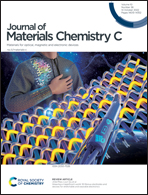Single-center LnIII ratiometric luminescent temperature probes based on singlet → singlet and singlet → triplet sensitizations†
Abstract
Luminescence thermometry based on LnIII systems has become a hotspot in nanotechnology, biotechnology, and integrated optics, whereas the self-calibrated two-band intensity ratiometric method excels in this. Herein, propyldiphenylphosphine oxide (pdppo)-functionalized polydimethylsiloxane (PDMS) was reacted with [Ln(X-bza)3(H2O)2] complexes (Ln = Eu, Tb, or Yb, X-bza = 3,5-dichlorobenzoate or 3,5-dibromo benzoate) leading to chemically bound [Ln(X-bza)3(pdppo)2]-PDMS membranes. The systems were used as luminescent temperature probes by exploiting a new strategy based on two different thermally dependent excitation channels arising from spin-allowed singlet → singlet or spin forbidden singlet → triplet transitions. To define the thermometric parameter, the intensity ratio of the LnIII emission spectra measured upon singlet → singlet or singlet → triplet excitation was considered, which enables achieving ratiometric single-centered EuIII or TbIII or YbIII-based luminescent temperature probes within 50–320 K. The maximum thermal sensitivity lies within 0.5–1.6% K−1 whereas the largest value was accomplished for [Yb(3,5-bbza)3(pdppo)2]-PDMS (1.6% K−1 at 120 K), which is among the best value reported for NIR-emitting single-center LnIII luminescent temperature probes.



 Please wait while we load your content...
Please wait while we load your content...